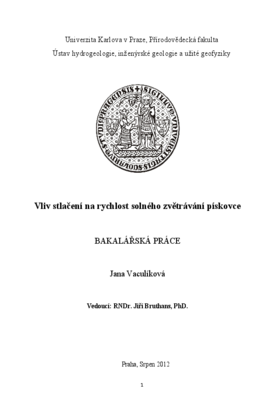Vliv stlačení na rychlost solného zvětrání pískovce
Effect of compression on salt weathering rate of sandstone
bakalářská práce (OBHÁJENO)

Zobrazit/
Trvalý odkaz
http://hdl.handle.net/20.500.11956/43327Identifikátory
SIS: 119258
Kolekce
- Kvalifikační práce [19100]
Autor
Vedoucí práce
Oponent práce
Schweigstillová, Jana
Fakulta / součást
Přírodovědecká fakulta
Obor
Hospodaření s přírodními zdroji
Katedra / ústav / klinika
Ústav hydrogeologie, inž. geologie a užité geofyziky
Datum obhajoby
12. 9. 2012
Nakladatel
Univerzita Karlova, Přírodovědecká fakultaJazyk
Čeština
Známka
Výborně
Cílem této práce bylo zjistit, zda má na rychlost solného rozpadu vliv míra stlačení horniny. Zkoušky byly prováděny na několika typech hornin, převážně na pískovcích z ČR a USA. K prvním zkouškám byly použity bloky střeleckého pískovce, které byly zatíženy závažím o hmotnosti 6 - 24 kg, zvolna saturovány roztoky NaCl, CaSo₄. H₂O a KAl(SO₄)₂. 12 H₂O a sušeny při pokojové teplotě. Protože rychlost zvětrání byla příliš pomalá, byla u dalších hornin použita jiná metodika. Další vzorky byly staženy ocelovou konstrukcí pomocí momentového klíče na hodnotu 0,75 Nm, což přibližně odpovídá jednoosému stlačení 1,2 MPa. Takto stažené vzorky byly podrobeny zkouškám upraveným podle normy EN 12370, tedy saturovány roztokem Na2SO4 a následně sušeny v peci. Cyklus se opakoval, dokud se vzorek nerozpadl, nebo jeho hmotnost neklesla pod 10 gramů. Ztráta hmotnosti po jednotlivých cyklech byla vynášena do grafů, podle kterých byly zkoušky vyhodnoceny. Přibližně po prvních dvou cyklech byl pozorovatelný nárůst hmotnosti díky krystalizaci solí uvnitř vzorků, po cyklech následujících už vzorky začaly hmotnost ztrácet. Všechny stažené vzorky vydržely více cyklů, než jejich nestažené protějšky, které se velmi intenzivně rozpadaly. Experiment dále pokračuje, abychom zjistili, o kolik cyklů vydrží stažené vzorky déle než...
The aim of this study was to investigate whether the uniaxial compression have any influence on the rate of salt decay. Tests were performed on several types of rocks, mainly sandstones from the Czech Republic and the USA. The first tests were made on Strelec sandstone blocks that were loaded with a mass of 6-24 kg, slowly saturated by solutions of NaCl, CaSO ₄. H ₂ O and KAl(SO ₄) ₂. 12 H ₂ O and dried at room temperature. Because the weathering rate was too low, another method was used for other rocks. Cubes cut fromrock were compressed by steel frame with a torque wrench to 0.75 Nm, which corresponds approximately to the uniaxial compression of 1.2 MPa. These compressed samples were tested according to a modified standard EN 12370, saturated by solution of Na2SO4 and subsequently dried in an oven. The cycle was repeated until the complete decay of the sample or until the residual weight of samples fall below 10 grams. Weight of the samples was plot over numbes of cycles. Approximately after first two cycles increase in weight due to the salt crystallization within samples was observed. In following cycles the samples begun to lose weight. All compressed samples wistand more cycles than their non-compressed counterparts. The experiment continues to find out how many cycles will the compressed...
